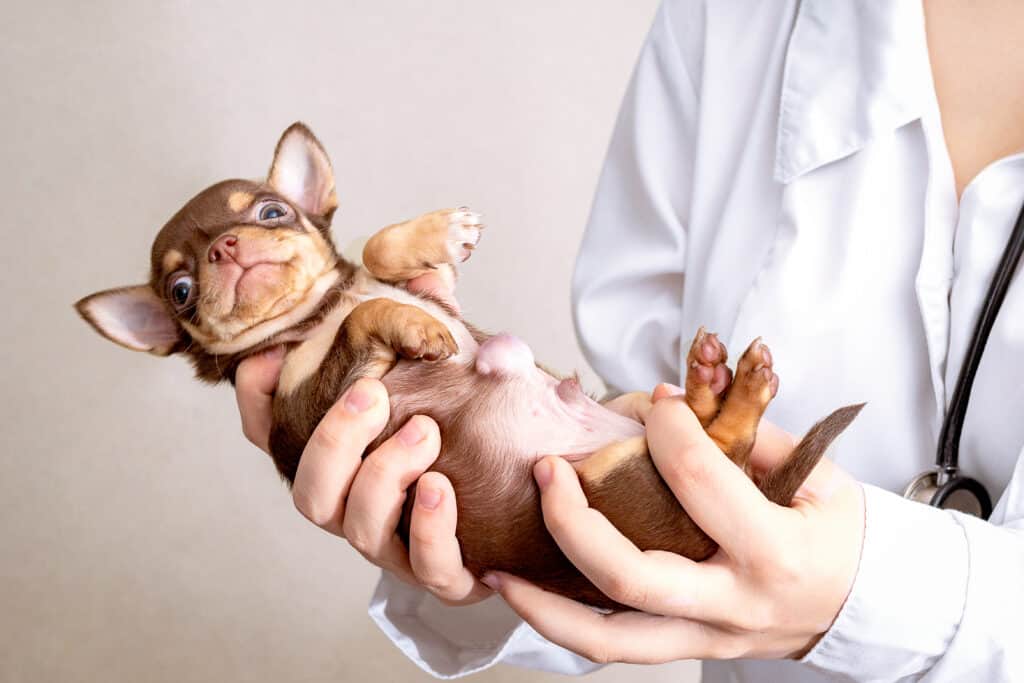Yes, dogs do have belly buttons! However, a dog’s belly button looks a little different from a human’s. The best time to spot a dog’s belly button is during puppyhood. However, they’re visible in adult dogs as well. Here is where you can find your dog’s belly button and any special care it may require.
Why Do Dogs Have Belly Buttons?

The umbilicus, or belly button, forms after the umbilical cord detaches from the puppy’s belly.
©olgagorovenko/Shutterstock.com
Dogs, like humans, are placental mammals. In fact, most mammals are placental mammals except for marsupials (like kangaroos or koalas) or monotremes (egg-laying mammals like the platypus). During gestation, a placenta forms in the womb and attaches to the uterine wall. The placenta is an organ structured to provide oxygen and nutrients to the fetus while also disposing of wastes from the fetus’s blood.
The fetus is attached to the placenta by an umbilical cord, and after birth, it is the cutting of the umbilical cord from the infant that forms the belly button. Humans are left with a round, “innie” or “outie” belly button. However, puppies tend only to have a small, flat scar after their umbilical cord stump dries up and drops off.
How Is the Belly Button Formed?
Each puppy develops inside their fluid-filled sac inside its mother’s womb. When they are born, those sacs are either broken during delivery, or if they are born with intact sacs, the mother dog (or dog owner) must break them open. From there, the mother dog tends to her puppies, licking them clean and chewing off the attached umbilical cords. If she doesn’t chew off the cords, the dog owner must cut those connections to the placenta.
A little stump will remain on the puppy’s belly, wither, and fall off over one to three days. The small, flat scar that remains is the puppy’s belly button.
Where to Find Your Dog’s Belly Button

The belly button is found in the middle of the dog’s abdomen.
©sophiecat/Shutterstock.com
Your dog’s belly button will be much more apparent when he is a puppy. As he ages, the scar will fade, and fur will eventually cover it. You can still locate it; it just might take some hunting. You will be looking for a small slit, rather than a round hole, on your dog’s belly.
Start at the midline of your dog’s abdomen, right below the rib cage. The skin around the belly button wrinkles slightly because of the small, vertical scar. Another sign of the belly button’s location is your dog’s belly fur may swirl around the area. Though it may be hard to spot, you can feel the scar tissue with your hands. It’ll be a firmer area of skin that will be noticeably different from the rest of the belly skin. That is your dog’s belly button.
How to Care for Your Dog’s Belly Button

If the area around the belly button protrudes, your puppy may have an umbilical hernia and should be seen by a veterinarian.
©Lara Ezhkova/Shutterstock.com
Unlike your dog’s teeth or ears, there isn’t any special upkeep or care for your dog’s belly button. Keeping the area clean and the skin healthy is enough.
However, a protruding belly button is something you should watch out for after birth. It can be a sign of an umbilical hernia. This condition is when a bulge of fat or tissue is under the area where the umbilical cord links the puppy to his mother. After the puppy is born, the ring of tissue in the abdominal wall sometimes doesn’t heal completely. And, while the skin heals over just fine, a hole is left in the abdomen where fat or sections of organs slip out. This leads to a mass where the belly button is, called an umbilical hernia.
Contact a veterinarian if you notice a protrusion where your puppy’s belly button is located. Sometimes, if the hernia is small (less than a couple of centimeters), a veterinarian may wait to see if it heals on its own. However, if your puppy has a bulge greater than one inch in diameter or is experiencing intestinal distress, treatment may be necessary. Some signs of intestinal distress are:
- Fever
- Continual crying or whimpering
- Lethargy
- Vomiting
- Not eating
- Stops having bowel movements
- Enlargement of the hernia area
Conclusion
While it may be hard to locate, your dog definitely has a belly button. And that small scar is a bond you and your dog have as placental mammals. So, next time you give your dog a belly rub, see if you can locate that slight scar.
The photo featured at the top of this post is © 2134626691/Shutterstock.com
Ready to discover the top 10 cutest dog breeds in the entire world?
How about the fastest dogs, the largest dogs and those that are -- quite frankly -- just the kindest dogs on the planet? Each day, AZ Animals sends out lists just like this to our thousands of email subscribers. And the best part? It's FREE. Join today by entering your email below.
Thank you for reading! Have some feedback for us? Contact the AZ Animals editorial team.







